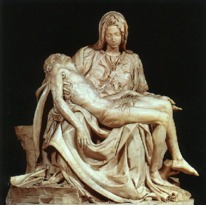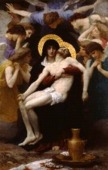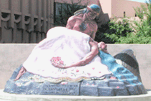
(pr. pee-ay-tah')
Examples:

Michelangelo
 Buonarroti
(Italian, 1475-1564), The Rome Pietà [
Buonarroti
(Italian, 1475-1564), The Rome Pietà [detail
of the faces of Christ and the Madonna], 1498-1500, marble,
entire height 68 1/2 inches,
maximum width of base
76 3/4 inches, maximum depth
27 1/8 inches, St. Peter's Basilica, Vatican, Rome. Carved in
Rome for the French King Charles VIII's ambassador to Pope Alexander
VI.
![]()

Michelangelo Buonarroti,
The
Florence Pietà, between 1550-1555, marble,
height 7 feet 5 inches (226
cm), width 4
 feet 3/8 inch,
depth 3 feet 1 inch, Cathedral
(Museo dell'Opera del Duomo), Florence.
feet 3/8 inch,
depth 3 feet 1 inch, Cathedral
(Museo dell'Opera del Duomo), Florence.
A second view. Mary is to the right, with
Mary Magdalene to the left. [Detail of the heads
of Jesus and Mary.] Standing is Joseph of Arimathea, who
gave his Lord his own freshly cut, unused tomb. The features
of Michelangelo's face can be seen in those of Joseph of Arimathea.
Michelangelo intended this sculpture to be placed above the altar
of his tomb chapel.

Michelangelo Buonarroti, The
Milan Pietà (Pietà Rondanini), marble,
height 6 feet 4 3/4 inches
(195 cm), Castello Sforzesco, Milan. [Detail of the heads
of Jesus and Mary.] Begun in 1553 and soon interrupted, this
is Michelangelo's last work, carved during the last year of his
life, 1564.

Matteo Rosselli (Italian, 1578-1650), Pietà, 1627, sanguine, 41.5 x 30.50 cm. This drawing was certainly inspired by Michelangelo's sculpture.
Alessandro Algardi (Italian, 1598-1654), Pietà, c. 1630s, octagonal bronze relief (a rectangular frame conceals corners), excluding flange: 11 3/4 x 11 3/4 inches (29.8 x 29.8 cm), Frick Collection, NY.

William-Adolphe Bouguereau (French, 1825-1905),
Pietà,
1876, oil on canvas,
230 x 148 cm. See academic,
French art, and kitsch.
![]()

Roy De Maistre (English, 1894-1968), Pietà, 1950, 152.4 x 114.3 cm,
Tate Gallery, London. See English art.
![]()

Luis Jiménez (American, 1940-2006), Southwestern Pietà, 1983, 30 x
44 inches, lithograph,
 collection of Gary D. Keller Cárdenas. The Hispanic Research
Center at Arizona State University offers further information about Luis Jiménez,
this artwork,
collection of Gary D. Keller Cárdenas. The Hispanic Research
Center at Arizona State University offers further information about Luis Jiménez,
this artwork, a large sculpture by Jiménez with the same title, and the contexts of these works, along with viewpoints for interpreting
them. See Chicano/a art.
Pietà is comparable to the subjects of these works:

Petrus Christus (Netherlandish, active by
1444, died 1475/76), The Lamentation, c. 1450, oil
on wood panel,
overall 10 1/8 x 14 inches (25.7 x 35.6 cm); painted surface
10 x 13 3/4 inches (25.4 x 34.9 cm), Metropolitan Museum of Art,
NY.

Édouard Manet (French, 1832-1883),
The Dead Christ and the Angels, 1864,
oil on canvas,
70 5/8 x 59 inches (179.4 x 149.9 cm), Metropolitan Museum of
Art, NY.
Also see expression and Madonna.
https://inform.quest/_art